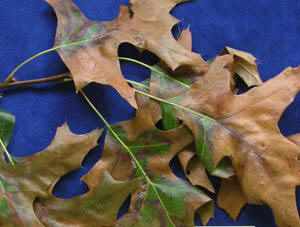|
 Many and varied topics Many and varied topics
By John
Fulton
 Send a link to a friend
Send a link to a friend
[August 12, 2010]
This week I thought I would cover, in
short form, many different topics. There seem to be many things
going on at this time, but most are continuations of earlier
problems. Hopefully you will at least be a little better informed
after reading this week's offering.
|
 Let's start with
maple trees. Many have decided to shed all
their leaves in response to the fungi, such as anthracnose, and
the brutal beating they took from the wind earlier this year.
Others have dropped leaves on portions of the tree, while
retaining leaves on other parts. This is the result of the wind
blasting. To check for possible recovery, inspect the buds on
the tree and see if they are plump and are green inside. You can
also scrape the bark on the ends of twigs with your fingernail.
If the area under the bark is green, and buds are plump and
green, there is still hope for next year. Let's start with
maple trees. Many have decided to shed all
their leaves in response to the fungi, such as anthracnose, and
the brutal beating they took from the wind earlier this year.
Others have dropped leaves on portions of the tree, while
retaining leaves on other parts. This is the result of the wind
blasting. To check for possible recovery, inspect the buds on
the tree and see if they are plump and are green inside. You can
also scrape the bark on the ends of twigs with your fingernail.
If the area under the bark is green, and buds are plump and
green, there is still hope for next year.

Some area oak trees,
particularly pin oaks, continue to show the signs of bacterial
leaf scorch. This starts as spots on leaves. The spots merge and
the leaves then fall prematurely. The next phase is the dying of
branches up the tree, followed in a couple of years by dead
branch ends. Unfortunately there is no cure for this Midwestern
problem.
There has just been a large-scale research project done that
indicates you may extend the life of these trees by a few years
with early treatments of antibiotics. It requires something like
oxytetracycline since the infection is from a bacteria. Early is
best in both the stage of the disease and timing in the year.
Best results in the study were about three weeks after full leaf
expansion. Remember, this just prolongs the inevitable. It is
not a cure.
We are at a possible time to control Zimmerman pine moth.
This is one of "that kind of borers." It generally affects only
severely weakened trees and goes just under the bark to girdle
the cambium layer at a branch whorl. It seems like older Scotch,
red and Austrian pines are favorites when they begin to decline.
There are other problems that cause the sap to leak out, and
they include diseases and birds. Frequently, the damage from a
severe infestation of the pine moth leads to the branch, or top,
breaking off in a windstorm. Permethrin is the insecticide of
choice for the attempt to control the pine moth, and it should
be applied as a broadcast spray concentrating on the branch
junctions and main trunk.
[to top of second column] |
 Crabgrass continues to get worse and may even compose most of
some lawns at this time. Control is really not an option now, as
crabgrass is an annual coming from seed every year. This means it
will probably die within about a month anyway. Next spring, two
applications of a preventive treatment, with one around April 1 and
another about June 1, would be the best plan. Mowing at a 2.5- to
3-inch height would also be beneficial. At least the absence of a
preventive treatment would allow for putting down new seed this fall
(Aug. 15 to Sept. 10).

Keep up with spray programs for apples until shortly before
harvest. This will help control the sooty mold, which looks like
charcoal dust on apples. It does scrub off, but notice I said scrub
and not rub. Sooty mold is usually worse on the yellow-type apples,
or at least more noticeable.
Also, the population of spiders, crickets and other home invaders
has grown by leaps and bounds the past week or so. This means to
keep up the foundation treatments to provide a protective barrier
against these insects. Permethrin or bifenthrin insecticides are the
most commonly used now.
[By
JOHN FULTON,
University of Illinois Extension, Logan County]
 |